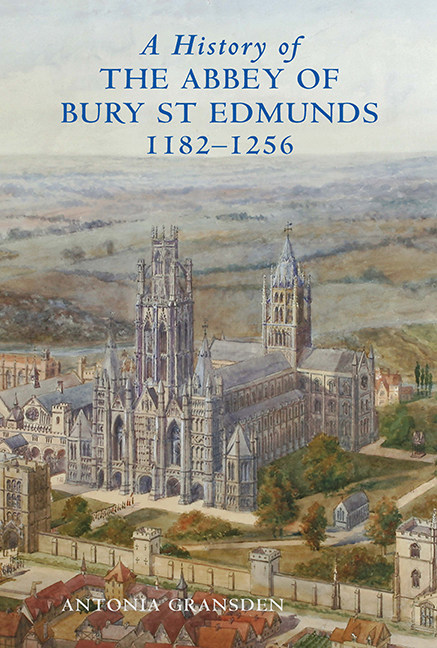Book contents
- Frontmatter
- Dedication
- Contents
- List of plates
- List of figures
- Preface
- Editorial Note
- Epigraph
- Acknowledgements
- Maps and plans (figures 1–9)
- Part I Samson of Tottington, Abbot 1182–1211
- 1 Samson's biographer, Jocelin of Brackland (de Brakelond), and his work
- 2 Samson's early life and career
- 3 Samson's election to the abbacy
- 4 The early years of Samson's abbacy and reform of estate management
- 5 Conflict with the convent
- 6 Relations with the town of Bury St Edmunds
- 7 Samson and secular law
- 8 Samson and the knights of St Edmund
- 9 Relations with the Angevin kings
- 10 Samson and the papacy
- 11 Samson as a builder
- 12 Religious and intellectual life under Samson
- 13 Samson's death and burial
- PART II The Abbey 1212–1256
- APPENDICES
10 - Samson and the papacy
from Part I - Samson of Tottington, Abbot 1182–1211
Published online by Cambridge University Press: 29 April 2017
- Frontmatter
- Dedication
- Contents
- List of plates
- List of figures
- Preface
- Editorial Note
- Epigraph
- Acknowledgements
- Maps and plans (figures 1–9)
- Part I Samson of Tottington, Abbot 1182–1211
- 1 Samson's biographer, Jocelin of Brackland (de Brakelond), and his work
- 2 Samson's early life and career
- 3 Samson's election to the abbacy
- 4 The early years of Samson's abbacy and reform of estate management
- 5 Conflict with the convent
- 6 Relations with the town of Bury St Edmunds
- 7 Samson and secular law
- 8 Samson and the knights of St Edmund
- 9 Relations with the Angevin kings
- 10 Samson and the papacy
- 11 Samson as a builder
- 12 Religious and intellectual life under Samson
- 13 Samson's death and burial
- PART II The Abbey 1212–1256
- APPENDICES
Summary
Jocelin writes:
Seven months had not passed since [Samson's] election when, lo and behold! letters of the pope [Lucius III] were brought to him, appointing him a judge delegate for the hearing of cases, a task for which he had neither the knowledge nor the experience. … Thereupon, he called to himself two clerks learned in [canon] law to be his associates and used their advice in ecclesiastical matters, and he studied the decrees and decretals whenever he had time. Thus, by studying books and hearing cases, he soon became a prudent judge, who proceeded in court according to the forms of law.
The truth of Jocelin's statement is born out by what is known about Samson's career as a papal judge delegate. Twenty-five mandates addressed to him by Innocent III survive or are known to have once existed: they concern judicial or administrative business. Other mandates will have been lost. Although the pope appointed whom he pleased to determine appeals to the curia, it was quite usual for him to appoint the petitioner's nominee or nominees. The frequency with which Samson was employed indicates that Samson's fellow countrymen as well as Innocent himself regarded him as an able judge in ecclesiastical matters. The fact that he would tend to be biased in favour of Benedictine monks must have encouraged them to nominate him as a judge delegate in their disputes.
Conflict between the secular clergy and the religious was a feature of the late twelfth and early thirteenth centuries. It might arise because a secular bishop, fired by reforming zeal, tried to hold a visitation of a highly privileged and wealthy Benedictine monastery, especially if he considered that the administration was lax and the Rule not properly observed. A number of disputes were between secular bishops and their monastic chapters. In general, a secular chapter, composed of prebendary canons, was more useful to a bishop than one composed of monks living communally in the cathedral priory. But, in addition, a bishop might want to reform the priory or simply enrich himself at its expense. The latter cause of conflict was exacerbated because often the line dividing a bishop's property from that of his cathedral priory was not clear. The various disputes, whatever their causes, resulted in numerous appeals to Rome by aggrieved parties.
- Type
- Chapter
- Information
- A History of the Abbey of Bury St Edmunds, 1182–1256Samson of Tottington to Edmund of Walpole, pp. 68 - 82Publisher: Boydell & BrewerPrint publication year: 2007



